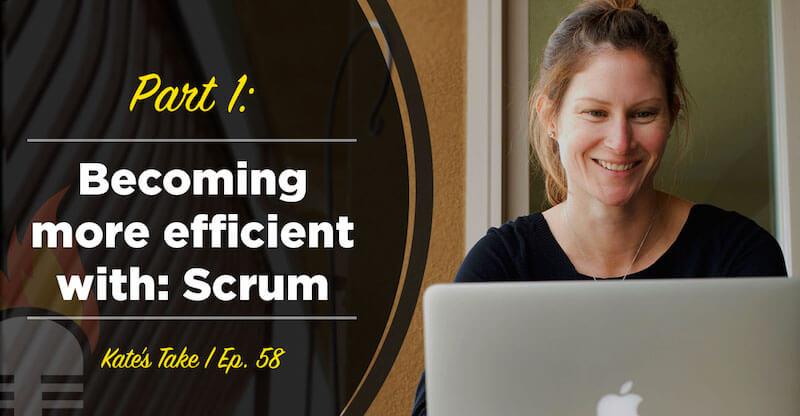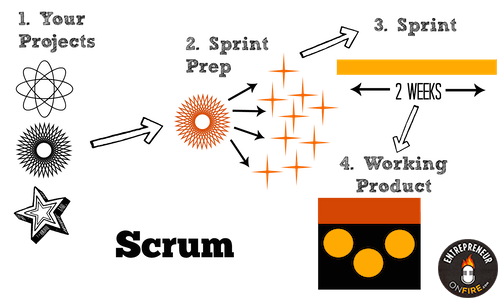
Scrum is a pretty funny word, but it’s a powerful concept used in the software development space that can also be implemented in your business.
Free and amazing trainings!
Free Podcast Course: Learn how to create and launch your podcast!
Your Big Idea: Discover Your Big Idea in less than an hour!
Part I: Becoming more efficient with: Scrum
I started reading about and studying this whole “Scrum” thing on a strong recommendation from a friend. His recommendation came on the heels of me raving about Essentialism, a book that has changed the way I think about time management and saying “no”.
Essentially, you need to read that book if your time is important to you.
But back to Scrum
When I started checking out the process and idea behind this concept, it reminded me of something I implemented a few months back: theming my days. More on that in another post (cause it’s HUGE!)…
Scrum takes theming your days to a whole new level: it’s more like theming your week – or month – which is referred to as a “sprint”: a period of time when you’re fully focused on a single project in order to get it to completion.
The whole idea with Scrum is that you fully focus on a single project (one task at a time) in order to go from whatever step you’re at right now to step done.
No distractions, no pauses, no excuses.
Here’s what the Scrum process looks like:

Looks like a pretty amazing process, doesn’t it?
That’s because it is.
Ah-ha!
Since I got back from my recent “workcation” in Puerto Vallarta, I’ve shared with you the ah-ha moment I had while on the hot seat during one of our masterminds, which was realizing, embracing and starting to leverage what I’m best at: systems and processes. If you want to hear a bonus episode I did on Kate’s Take about that hot seat experience, you can listen to that here.
So I thought, “What better way to share what I’m best at with you than to talk about the power of theming your days, along with this idea of Scrum, to help you start creating systems and processes in your own business?”
If not you’re sold on the whole “systems and processes” thing, just replace that with: “Whatever Kate is about to cover will help me become more efficient, get more done, and make more money in my business“.
Sound good?
How to implement Scrum in your business
Since we’ve already started to dive into Scrum, let’s first talk about how you might implement this concept in your business (here in Part I), and in our next post (Part II) we’ll dive deep into how you might implement the concept of theming your days in your business.
The plan
The Scrum process starts with you creating a plan. If you have a team you’ll be working with on the project you select, then they should be involved in this entire process.
- What projects do you have in line to complete?
- Which of those projects is most critical? (Choose the one you’ll work on during your first sprint & invite your team – if applicable – to your planning meeting.)
- Once you have a project, establish how long your sprint will be in order to complete that project. (Set a deadline! Scrum says to choose a sprint anywhere from 7 – 30 days in length)
- Assign individual tasks to that project. (What is required to get that project from where it is right now to completion, and who will handle each of those tasks?)
- Given your deadline, how much time will you assign to each of those tasks take? (Be specific and as accurate as possible given your deadline.)
The sprint
Once you have your plan in place, you’re ready to start your sprint! Logically, your planning meeting would be based on your sprint start date; let’s say you have your planning meeting on Friday, then you would start your sprint on Saturday (or Monday).
Then, every day of your sprint should end with a team (or individual if you’re working alone) check-in meeting (Scrum calls this a daily Scrum meeting). During this meeting, you’ll spend 15 minutes max reviewing deliverables:
- What did you accomplish yesterday;
- What did you accomplish today;
- What (if anything) stands in your way of reaching your goal?
During your sprint, you’ll focus completely on the task at hand: remember, no distractions, no pauses, no excuses.
The review
At the end of your sprint, you should hold two separate meetings (either with yourself or with your team).
No: it is not weird to hold a meeting with yourself.
The first meeting is a sprint review
This is your opportunity to actually “submit” (or publish or launch) what you created. This is also the time to call out any tasks you said you would finish, but that you didn’t.
The second meeting is a sprint retrospective
This is your opportunity to improve. In our 2014 Review, John and I covered in detail the importance of taking a look back at what has worked for you in the past, and of equal importance, what hasn’t worked for you. In doing so, you’re allowing yourself to double down on what did work, and NOT do what didn’t work for you in the future.
Are you in?
I’m not just writing about stuff that “might work” here.
John and I implementing the Scrum process into our workflow here at EntrepreneurOnFire has helped us become more efficient, get more done, and make more money in our business.
A quick example: we used Scrum to create and launch Podcasters’ Paradise, a community now filled with over 1,800 podcasters who are looking to create, grow and monetize their own podcast.
So whether you love planning and processes or not, I think we can agree in closing that you do love building and growing your business.
